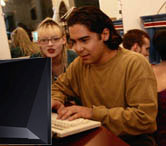
MONDAY, Aug. 16 (HealthDay News) — Folks with Internet connections are more likely to be in a romantic relationship than folks without access to the Web, a new study shows.
And it’s likely that the Web will soon replace the old standby, “friends,” as the number one way to meet your soul mate, Stanford researchers were to report Monday at the American Sociological Association annual meeting in Atlanta.
Virtual connections are proving especially fruitful for lonely hearts from minority or tough-to-find-a-good-mate segments, such as middle-aged heterosexuals and gays and lesbians.
“We’re seeing this as a trend now as more generations are embracing the Internet, and with competing demands on people’s schedules, this seems like the next logical step,” said Simon Rego, director of clinical training at the American Institute for Cognitive Therapy in New York City.
“Clinically, I’ve certainly seen an increase in the people utilizing the Web, and this study validates that,” said Theresa Quinn, an assistant professor of psychiatry and behavioral science at Texas A&M Health Science Center College of Medicine and director of psychology at Scott & White College Station Clinic. “I think it’s more pervasive than people expected.”
In 1940, 20 percent of people were introduced to their mate by friends, with that number reaching 40 percent in 1990.
Now that trend is in decline, as are other local ways of meeting people, such as community groups, school ties or co-workers, the study authors stated.
The researchers drew their conclusions from a nationally representative survey called How Couples Meet and Stay Together. The survey also included in-depth interviews with participants.
More than 80 percent of people surveyed who had an Internet connection at home were coupled up (either married or living with a domestic partner). For adults without Internet access, the rate was 62.8 percent.
Three-quarters of partners in couples that met on the Internet had had no idea that a mate was waiting in cyberspace. In other words, they had had no non-virtual contact beforehand.
Online venues most often cited as good meeting places were Web dating sites, virtual classifieds, chat rooms, social networking Web sites (such as Facebook or MySpace) and through Internet games.
There appeared to be another advantage to meeting online: Breakup rates were higher among couples who had met the old-fashioned way, through friends — 9.6 percent vs. 8.1 percent who had met through other means.
Groups that previously had little hope are also now finding their odds greatly heightened.
“What’s particularly intriguing is the notion that for select groups that may have been marginalized in the past, [this provides] great opportunities to connect to people which may not have been readily available in traditional methods [such as] friends or gay clubs,” Rego said.
The study describes one lesbian woman in the South who started meeting people in her ZIP code using America Online (now called AOL). Previous forays into a gay bar and a gay church had been fruitless.
The same holds true for the older set.
“I have a lot of people in the 30-to-40 age range who are either separated or divorced or had put their career first and suddenly they realized the friendship networks that they would typically have used have dried up because those friends are married or forming families and so don’t go out as frequently,” Rego said. “Now you’ve got this whole medium where potentially millions of people come together.”
Quinn is also seeing more middle-aged heterosexual singles meeting over the Internet, as well as gay and lesbians.
“The message of it is clear. This trend is happening and it seems logical,” Rego said. “I imagine that this will continue to grow as people grow into the Internet and embrace it.”
More information
Applied Sociology has more on how the Internet is changing the social landscape.

